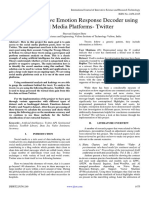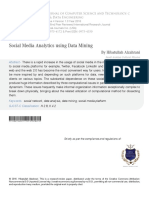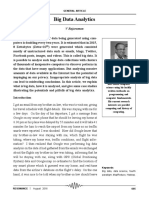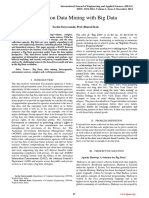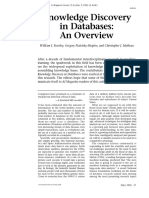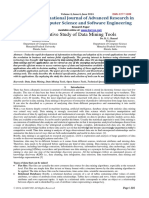Professional Documents
Culture Documents
Literature Survey On Sentiment Analysis of Twitter Information Exploitation Hadoop Framework
Original Title
Copyright
Available Formats
Share this document
Did you find this document useful?
Is this content inappropriate?
Report this DocumentCopyright:
Available Formats
Literature Survey On Sentiment Analysis of Twitter Information Exploitation Hadoop Framework
Copyright:
Available Formats
Volume 3, Issue 4, April – 2018 International Journal of Innovative Science and Research Technology
ISSN No:-2456-2165
Literature Survey on Sentiment Analysis of Twitter
Information Exploitation Hadoop Framework
Kumari Bhawana, Dr. Rajesh S L,
Department of Computer Science and Engineering, Department of Computer Science and Engineering
SET- Jain University Bangalore, India
Abstract:- This In this era, Social Medias generates great merchandise and sporting events .These opinion is named
deal of information daily it's unimaginable to store sentiment analysis. These reviews, comments categorical
great deal of information during an ancient info. Here the emotions that are generally classified in sentimental analysis
challenge isn't solely to learn information, however as while not emotions (neutral), happy (positive) or sad
conjointly to access and analyze the information requested (negative) counting on their polarity determined by varied
during a given amount of your time. one in every of the algorithms, tools, techniques, databases. In this paper, we use
favored implementations to resolve massive Data’s sentiment analysis for twitter information by exploitation
previous challenges is that the use of Hadoop. Any Hadoop framework, flume, spark, Kafka, and algorithmic rule.
publication during a social network typically receives a
whole bunch and thousands of comments and it's
tough for a user to research all the comments for the
opinion of the individuals. So, currently, sentiment
analysis is that the best to seek out the opinion of
individuals concerning any product, organization,
academic, politics, sports etc. By exploitation the social
media like twitter, Facebook, Whatsapp, Google+,
Instagram etc. whereas Twitter information is very
instructive, presents a challenge to analysis attributable to
its monumental and chaotic nature. During this we tend to
focus regarding a way to do sentiment analysis of huge
quantity of twitter information by exploitation Hadoop
and algorithmic rule and conjointly increase the accuracy
of sentiment analysis in minimum needed time.
Keywords:- Twitter data, Hadoop, Kafka, spark, Random
forest algorithm.
I. INTRODUCTION
This Now daily individuals use social networks to Fig 1:- System Architecture
urge info on the recent topic and opinion on it topic within the
organization, the film industry and Hollywood industries, Twitter: it's a web social networking website
politics, sports and far a lot of. With the wide growth within wherever users post and post tweets.
the use of on-line social networks, the quantity of information Hadoop: it's a framework that's used for the
saved is on the market as a preference of users compared to distributed process of enormous knowledge sets.
any product, services provided by varied organizations or with Flume: It accustomed collect knowledge from Twitter and
relation to any political drawback and concerning any sports transfer massive amounts of transmission knowledge to
events. Twitter is additionally a social network for getting info Franz Kafka.
in real time. Users share their everyday activities, thoughts, Kafka-It provides a unified, high performance and low
feedbacks in messages, referred to as tweets. With this latency platform for managing period and queuedk
intensive use of Twitter, individuals come back from nowledge feeds.
everywhere the globe Use this platform to share opinions on Spark-It provides a fast consultation, analysis and
films, analyses markets, study the political inclination of transformation of knowledge on an out sized scale.
voters and react to sporting events. Opinion found in
comments, tweets and reviews are helpful each for the
organization and for the user of such services, academics,
IJISRT18AP269 www.ijisrt.com 166
Volume 3, Issue 4, April – 2018 International Journal of Innovative Science and Research Technology
ISSN No:-2456-2165
II. RELATED WORK D. Spark
Spark adds to Hadoop the workloads in memory for
A. Hadoop ETL, Machine Learning and information Science workloads.
Apache Hadoop- Hadoop may be a complete scheme “Apache Spark may be a quick in-memory processing engine
of open supply comes that has North American nation with the with elegant and communicative development genus Apies to
structure to manage massive information. it's written in change information staff to with efficiency perform
Java that permits distributed process of enormous information transmission, machine learning, or SQL workloads” that need
sets into teams of computers mistreatment straightforward speedy repetitious access to information sets. Spark
programming models. This application works in associate additionally includes MLlib, a library that has a growing set of
atmosphere that has space for storing and distributed machine algorithms for common information science
computing in laptop clusters. the employment of Hadoop techniques: Classification, Regression, cooperative Filtering,
within the analysis of feelings is attributable to the actual fact Grouping and Dimensional Reduction.
that text-based information doesn't naturally match into
a electronic database. Hadoop may be a convenient place to III. LITERATURE SURVEY
explore and perform analysis on this data.
The paper [1] (Kaur, 2015) describe regarding
B. Flume geographic area flood information set collected from twitter
A Flume may be a service to transmit records to Hadoop. and realize the opinion of individuals. They used Naive Bayes
it's strong and fault tolerant with adjustable formula for the classification of information and result they
dependableness mechanisms for fail over and recovery. got 67% accuracy. They need collected several resolution
it's a straightforward and versatile design supported from the individuals that are useful for each government and
transmission information streams. “It is strong and fault non-government organization to handle such scenario in an
tolerant with adjustable dependableness mechanisms and exceedingly higher manner. These strategies simpler than
plenty of fail over and recovery mechanisms”. it's a lexicon-based formula.
distributed, reliable and accessible service to gather, mixture
and with efficiency move massive amounts of registration The paper [2] (Paul, 2017) describe regarding the
information. Use a straightforward practicable information ultimate match of Indian premier league sport event 2015.
model that allows on- line analytical application. It has three Objective of this paper to research standardity {the
elements: - recognition} of IPL match and that player are popular and that
team is dominate. They need used Hadoop and Map cut back
Flume information Source- A supply is that the element artificial language. They got result like MS Dhoni is most
of associate agent that receives information from the talked regarding player and metropolis Indians team fairly
information generators and transfers them to at least one dominated. This technique gave higher result.
or a lot of channels within the sort of channel events.
The paper [3] (Mittal, 2016) describe the requirement
Flume information Channel- A channel may be a and impact of the sentiment analysis on on-line platform. They
temporary store that receives events from the supply and need additionally bestowed a listing of sentiments of
stores them in buffers till they're consumed by sink. emotions, interjections and comments that are extracted from
It acts as a bridge between the sources and sinks. posts and standing updates. They need got result to knowing
whether or not {the on-line the web the net} reviews and posts
Flume information Sink- A receiver stores information in are being useful to client or not and that on-line websites being
centralized stores like Franz Kafka, HBase and HDFS. most popular by the purchasers.
Consume the information (events) of the channels and
deliver them to the destination. The paper [4] (Anto, 2016) describe the merchandise
rating mistreatment sentiment analysis. In promoting of any
C. Kafka product the producer can get the proper result from the client
A fast, ascendible and fault-tolerant electronic feedback. After got feedback they'll changes to his
messaging system. “Apache Franz Kafka supports a good vary product in step with the feedback. Some users continually fail
of use cases as a generic electronic messaging system for to convey their feedbacks. Objective of this paper is to avoid
situations wherever high performance, reliable delivery and the problem of providing feedbacks and supply the technique
horizontal measurability area unit important”. Franz Kafka is which might provide automatic feedback on the premise of
employed to transmit information in period of time information collected from twitter. They used the technique
information, applications and flow analysis systems. Franz SVM and got result eightieth accuracy. This system offer
Kafka works in conjunction with Apache Storm, Apache quick and valuable feedback.
HBase and Apache Spark for period of time analysis and
playback of streaming information. The paper [5] (Saragih, 2017) describe regarding the
client engagement by analysis the comments on social media
IJISRT18AP269 www.ijisrt.com 167
Volume 3, Issue 4, April – 2018 International Journal of Innovative Science and Research Technology
ISSN No:-2456-2165
in transport on-line. They used technique TF-IDF. The result [4]. Mittal, S. A. (2016). Sentiment Analysis of E-Commerce
shows that the class “Feedback system by driver” and and Social Networking Sites. IEEE, pp. 2300-2305.
“Feedback system by user” have the foremost comments for 3 [5]. Paul, R. (2017). Big Data Analysis of Indian Premier
means that of transports on-line, whereas class “service quality League using Hadoop and MapReduce. IEEE, (pp. 1-6).
for driver “has the littlest comments. This feedback of social [6]. Saragih, M. H. (2017). Sentiment Analysis of Customer
media is accustomed evaluate the performance of this business Engagement on Social Media in Transport Online. IEEE,
transport on-line. pp. 24-29.
[7]. Shahare, F. F. (2017). Sentiment Analysis for the News
The paper [6] (Shahare, 2017) describe regarding the Data Based on the social Media. IEEE, pp. 1365-1370.
sentiment analysis of reports information of social media They
need used technique naive Bayes and Levenshtein formula
that confirm the feeling into totally different classes from
social media news information. This technique provides {the
higher the higher} performance for real time news information
on social media and additionally provides better lead to term
of accuracy. They got the result that the Levenshtein formula
provides an awfully simple to text process on information. It
works quick and supply most level of accuracy to process
great deal of information.
This paper [7] (Mamgain, 2016) describe
regarding the sentiment analysis of people’s opinions relating
to high faculties in India. They need represented comparison
between the result obtained by the subsequent machine
learning algorithms: Naive Bayes and SVM and Artificial
Neural Network model: Multilayer Perception. Naive Bayes
{Thomas Bayes mathematician} outperforms SVM for the
aim of matter polarity classification that is fascinating as a
result of the model utilized by Naive Bayes is easy (use of
freelance probabilities) and therefore the likelihood estimates
made by such a model are of caliber. Yet, the classification
selections created by the Naive Bayes model portray a decent
accuracy as a result of whenever a call with the upper
likelihood is being created.
IV. CONCLUSION
The Sentiment analysis is incredibly common technology in
today’s world. Most of works has been tired these fields. In all
these paper several analysis has been done on sentiment
analysis of social media knowledge and that they have used
several techniques and technology like Naive Thomas Bayes,
Hadoop Framework and Map scale back programming, TF-
IDF, lexicon-based, SVM classifier, Levenshtein algorithmic
rule. So in my analysis work I need to extend the accuracy and
potency and reduce the time overwhelming to analysis of
Posts, tweets on a twitter.
REFERENCES
[1]. Anto, M. P. (2016). PRODUCT RATING USING
SENTIMENT ANALYSIS. IEEE, pp. 3458-3462.
[2]. Kaur, H. J. (2015). Sentiment Analysis from Social Media
in Crisis Situations. IEEE, (pp. 251-256).
[3]. Mamgain, N. M. (2016). Sentiment Analysis of Top
Colleges in India Using Twitter Data. IEEE, pp. 525-530.
IJISRT18AP269 www.ijisrt.com 168
You might also like
- Real Time Text Mining On Twitter Data: Shilpy Gandharv Vivek Richhariya RichhariyaDocument5 pagesReal Time Text Mining On Twitter Data: Shilpy Gandharv Vivek Richhariya RichhariyaPrashantHegdeNo ratings yet
- Sentimental Analysis of Social Media For Stock Prediction Using HadoopDocument5 pagesSentimental Analysis of Social Media For Stock Prediction Using HadoopInternational Journal of Innovative Science and Research TechnologyNo ratings yet
- Twitter Sentiment Analysis With TextblobDocument6 pagesTwitter Sentiment Analysis With TextblobInternational Journal of Innovative Science and Research TechnologyNo ratings yet
- Sentiment Analysis of Tweets Using Apache SparkDocument9 pagesSentiment Analysis of Tweets Using Apache Sparkritika singhNo ratings yet
- An Implementation of Hybrid Enhanced Sentiment Analysis System Using Spark ML Pipeline: A Big Data Analytics FrameworkDocument8 pagesAn Implementation of Hybrid Enhanced Sentiment Analysis System Using Spark ML Pipeline: A Big Data Analytics FrameworkMayank TomarNo ratings yet
- Crowd Based Live Emotion Response Decoder Using Social Media Platforms - TwitterDocument5 pagesCrowd Based Live Emotion Response Decoder Using Social Media Platforms - TwitterInternational Journal of Innovative Science and Research TechnologyNo ratings yet
- Big Data Analytics - ProjectDocument27 pagesBig Data Analytics - ProjectRam Jain50% (2)
- Real Time Twitter Data Analysis Using Hadoop EcosystemDocument16 pagesReal Time Twitter Data Analysis Using Hadoop EcosystemAbdifatah OsmanNo ratings yet
- Social Media Based Sentimental Analysis Using Hive and FlumeDocument4 pagesSocial Media Based Sentimental Analysis Using Hive and FlumevenkatNo ratings yet
- Big Data Analysis Using Hadoop: A Survey: August 2015Document6 pagesBig Data Analysis Using Hadoop: A Survey: August 2015DanNo ratings yet
- 2 Big Data AnalysisDocument10 pages2 Big Data AnalysisAnshi AgrawalNo ratings yet
- Big data examples for personalized marketing, inventory ordering & moreDocument10 pagesBig data examples for personalized marketing, inventory ordering & moreKritika ShergelNo ratings yet
- Flipkart and Big DataDocument5 pagesFlipkart and Big Datamrudula sankheNo ratings yet
- Mini ProjectDocument16 pagesMini ProjectLikhil GoudNo ratings yet
- Big Data NotesDocument68 pagesBig Data NotesDrKrishna Priya ChakireddyNo ratings yet
- Mainreport PDFDocument29 pagesMainreport PDFJyotishmoy saikiaNo ratings yet
- Collaborative Filtering Techniques For GeneratingDocument5 pagesCollaborative Filtering Techniques For GeneratingycaredNo ratings yet
- Cloud & Big DataDocument5 pagesCloud & Big DataHenish KananiNo ratings yet
- Vickie Data AnalyticsDocument9 pagesVickie Data AnalyticsEleonor Victoria AliazarNo ratings yet
- Spark PDFDocument10 pagesSpark PDFNew MahoutsukaiNo ratings yet
- Data Warehouse Design From Social Media For Opinion AnalysisDocument8 pagesData Warehouse Design From Social Media For Opinion AnalysisSumit NaganathNo ratings yet
- Twitter Analysis On Real Time DataDocument7 pagesTwitter Analysis On Real Time DataIJRASETPublicationsNo ratings yet
- Papanikolaou Et Al. - 2016 - Just The Facts With PALOMAR Detecting Protest Events in Media Outlets and TwitterDocument8 pagesPapanikolaou Et Al. - 2016 - Just The Facts With PALOMAR Detecting Protest Events in Media Outlets and TwitterJOSÉ MANUEL MEJÍA VILLENANo ratings yet
- TOP 10 BIG DATA TRENDSDocument13 pagesTOP 10 BIG DATA TRENDSshah_81No ratings yet
- CCL MiniProjectDocument8 pagesCCL MiniProjectSakshi PawarNo ratings yet
- Introduction to Big Data TechnologiesDocument7 pagesIntroduction to Big Data Technologiessanjay joshiNo ratings yet
- A Case Study For Intelligent Event Recommendation: ArticleDocument21 pagesA Case Study For Intelligent Event Recommendation: ArticleBogdan VladNo ratings yet
- Sigmodwarehouse2010 PDFDocument8 pagesSigmodwarehouse2010 PDFSalih AnwarNo ratings yet
- Analyze 7 layers of social media data & toolsDocument2 pagesAnalyze 7 layers of social media data & toolsArifa KhadriNo ratings yet
- IJREST - Real Time TwitterDocument6 pagesIJREST - Real Time TwitterShashwat DarpNo ratings yet
- Social and Information Networks J-Component ReportDocument28 pagesSocial and Information Networks J-Component ReportTanishka KukrejaNo ratings yet
- 3 Social Media AnalyticsDocument4 pages3 Social Media AnalyticsAnna JonesNo ratings yet
- JournalNX - Big Data Data MiningDocument5 pagesJournalNX - Big Data Data MiningJournalNX - a Multidisciplinary Peer Reviewed JournalNo ratings yet
- Sales Analysis and Prediction Using PythDocument5 pagesSales Analysis and Prediction Using PythBhagyaprasad PatilNo ratings yet
- (IJCST-V10I4P1) :swagata Sarkar, Dhivya Balaje, Vibha V, Harish PichumaniDocument4 pages(IJCST-V10I4P1) :swagata Sarkar, Dhivya Balaje, Vibha V, Harish PichumaniEighthSenseGroupNo ratings yet
- Machine Learning and Cloud Computing: Survey of Distributed and Saas SolutionsDocument13 pagesMachine Learning and Cloud Computing: Survey of Distributed and Saas SolutionssfarithaNo ratings yet
- Emotion Recognition by Textual Tweets Classification Using Voting Classifier (LR-SGD)Document10 pagesEmotion Recognition by Textual Tweets Classification Using Voting Classifier (LR-SGD)MadhanDhonianNo ratings yet
- Big Data NOTES and QBDocument92 pagesBig Data NOTES and QBSivaNo ratings yet
- Big Data AnalyticsDocument22 pagesBig Data AnalyticsPavan ReshmanthNo ratings yet
- 10 1109@icict48043 2020 9112546Document6 pages10 1109@icict48043 2020 9112546realaryaroyNo ratings yet
- Review On Data Mining With Big Data: Savita Suryavanshi, Prof. Bharati KaleDocument3 pagesReview On Data Mining With Big Data: Savita Suryavanshi, Prof. Bharati KaleerpublicationNo ratings yet
- Sean Jordan Synthesis PaperDocument18 pagesSean Jordan Synthesis Paperapi-306603109No ratings yet
- Knowledge Discovery in Databases: An Overview: William J. Frawley, Gregory Piatetsky-Shapiro, and Christopher J. MatheusDocument14 pagesKnowledge Discovery in Databases: An Overview: William J. Frawley, Gregory Piatetsky-Shapiro, and Christopher J. Matheusdevin222No ratings yet
- Large Scale Sentiment Analysis On Twitter With Spark: Nikolaos Nodarakis Spyros SioutasDocument8 pagesLarge Scale Sentiment Analysis On Twitter With Spark: Nikolaos Nodarakis Spyros Sioutasjbsimha3629No ratings yet
- Project WorkDocument36 pagesProject WorkOrah SeunNo ratings yet
- Comparative Study of Data Mining ToolsDocument8 pagesComparative Study of Data Mining ToolsManolo Bermeo MartínezNo ratings yet
- Caper HCI2014Document7 pagesCaper HCI2014Discord YtNo ratings yet
- Big Data Analytics Overonline Transactional Data Set: Ipasj International Journal of Computer Science (Iijcs)Document5 pagesBig Data Analytics Overonline Transactional Data Set: Ipasj International Journal of Computer Science (Iijcs)International Journal of Application or Innovation in Engineering & ManagementNo ratings yet
- Big Data Analytics: Free Guide: 5 Data Science Tools To ConsiderDocument8 pagesBig Data Analytics: Free Guide: 5 Data Science Tools To ConsiderKeemeNo ratings yet
- Scalable Machine-Learning Algorithms For Big Data Analytics: A Comprehensive ReviewDocument21 pagesScalable Machine-Learning Algorithms For Big Data Analytics: A Comprehensive ReviewvikasbhowateNo ratings yet
- Hand Book: Ahmedabad Institute of TechnologyDocument103 pagesHand Book: Ahmedabad Institute of TechnologyBhavik SangharNo ratings yet
- Survey On Aspect-Level Sentiment AnalysisDocument18 pagesSurvey On Aspect-Level Sentiment AnalysisAayush SinghNo ratings yet
- Arabic Sentiment Analysis Using WEKA A Hybrid Learning ApproachDocument7 pagesArabic Sentiment Analysis Using WEKA A Hybrid Learning Approachdaniel.rabahdunordNo ratings yet
- Bda - 2020-21 - Iv - I CseDocument68 pagesBda - 2020-21 - Iv - I CseJitendra DangraNo ratings yet
- Review Paper On Big Data Analytics in Cloud Computing: July 2017Document6 pagesReview Paper On Big Data Analytics in Cloud Computing: July 2017Ogbodu Ejiro DesmondNo ratings yet
- An Apache Spark Implementation For Graph-Based Hashtag Sentiment Classification On TwitterDocument6 pagesAn Apache Spark Implementation For Graph-Based Hashtag Sentiment Classification On Twitterradhianie djanNo ratings yet
- Cognitive Computing Recipes: Artificial Intelligence Solutions Using Microsoft Cognitive Services and TensorFlowFrom EverandCognitive Computing Recipes: Artificial Intelligence Solutions Using Microsoft Cognitive Services and TensorFlowNo ratings yet
- Practical Machine Learning for Streaming Data with Python: Design, Develop, and Validate Online Learning ModelsFrom EverandPractical Machine Learning for Streaming Data with Python: Design, Develop, and Validate Online Learning ModelsNo ratings yet
- A Curious Case of QuadriplegiaDocument4 pagesA Curious Case of QuadriplegiaInternational Journal of Innovative Science and Research TechnologyNo ratings yet
- Analysis of Financial Ratios that Relate to Market Value of Listed Companies that have Announced the Results of their Sustainable Stock Assessment, SET ESG Ratings 2023Document10 pagesAnalysis of Financial Ratios that Relate to Market Value of Listed Companies that have Announced the Results of their Sustainable Stock Assessment, SET ESG Ratings 2023International Journal of Innovative Science and Research TechnologyNo ratings yet
- Adoption of International Public Sector Accounting Standards and Quality of Financial Reporting in National Government Agricultural Sector Entities, KenyaDocument12 pagesAdoption of International Public Sector Accounting Standards and Quality of Financial Reporting in National Government Agricultural Sector Entities, KenyaInternational Journal of Innovative Science and Research TechnologyNo ratings yet
- Food habits and food inflation in the US and India; An experience in Covid-19 pandemicDocument3 pagesFood habits and food inflation in the US and India; An experience in Covid-19 pandemicInternational Journal of Innovative Science and Research TechnologyNo ratings yet
- The Students’ Assessment of Family Influences on their Academic MotivationDocument8 pagesThe Students’ Assessment of Family Influences on their Academic MotivationInternational Journal of Innovative Science and Research Technology100% (1)
- Pdf to Voice by Using Deep LearningDocument5 pagesPdf to Voice by Using Deep LearningInternational Journal of Innovative Science and Research TechnologyNo ratings yet
- Fruit of the Pomegranate (Punica granatum) Plant: Nutrients, Phytochemical Composition and Antioxidant Activity of Fresh and Dried FruitsDocument6 pagesFruit of the Pomegranate (Punica granatum) Plant: Nutrients, Phytochemical Composition and Antioxidant Activity of Fresh and Dried FruitsInternational Journal of Innovative Science and Research TechnologyNo ratings yet
- Forensic Evidence Management Using Blockchain TechnologyDocument6 pagesForensic Evidence Management Using Blockchain TechnologyInternational Journal of Innovative Science and Research TechnologyNo ratings yet
- Improvement Functional Capacity In Adult After Percutaneous ASD ClosureDocument7 pagesImprovement Functional Capacity In Adult After Percutaneous ASD ClosureInternational Journal of Innovative Science and Research TechnologyNo ratings yet
- Machine Learning and Big Data Analytics for Precision Cardiac RiskStratification and Heart DiseasesDocument6 pagesMachine Learning and Big Data Analytics for Precision Cardiac RiskStratification and Heart DiseasesInternational Journal of Innovative Science and Research TechnologyNo ratings yet
- Optimization of Process Parameters for Turning Operation on D3 Die SteelDocument4 pagesOptimization of Process Parameters for Turning Operation on D3 Die SteelInternational Journal of Innovative Science and Research TechnologyNo ratings yet
- Scrolls, Likes, and Filters: The New Age Factor Causing Body Image IssuesDocument6 pagesScrolls, Likes, and Filters: The New Age Factor Causing Body Image IssuesInternational Journal of Innovative Science and Research TechnologyNo ratings yet
- The Experiences of Non-PE Teachers in Teaching First Aid and Emergency Response: A Phenomenological StudyDocument89 pagesThe Experiences of Non-PE Teachers in Teaching First Aid and Emergency Response: A Phenomenological StudyInternational Journal of Innovative Science and Research TechnologyNo ratings yet
- Design and Implementation of Homemade Food Delivery Mobile Application Using Flutter-FlowDocument7 pagesDesign and Implementation of Homemade Food Delivery Mobile Application Using Flutter-FlowInternational Journal of Innovative Science and Research TechnologyNo ratings yet
- Severe Residual Pulmonary Stenosis after Surgical Repair of Tetralogy of Fallot: What’s Our Next Strategy?Document11 pagesSevere Residual Pulmonary Stenosis after Surgical Repair of Tetralogy of Fallot: What’s Our Next Strategy?International Journal of Innovative Science and Research TechnologyNo ratings yet
- Comparison of Lateral Cephalograms with Photographs for Assessing Anterior Malar Prominence in Maharashtrian PopulationDocument8 pagesComparison of Lateral Cephalograms with Photographs for Assessing Anterior Malar Prominence in Maharashtrian PopulationInternational Journal of Innovative Science and Research TechnologyNo ratings yet
- Late Presentation of Pulmonary Hypertension Crisis Concurrent with Atrial Arrhythmia after Atrial Septal Defect Device ClosureDocument12 pagesLate Presentation of Pulmonary Hypertension Crisis Concurrent with Atrial Arrhythmia after Atrial Septal Defect Device ClosureInternational Journal of Innovative Science and Research TechnologyNo ratings yet
- Blockchain-Enabled Security Solutions for Medical Device Integrity and Provenance in Cloud EnvironmentsDocument13 pagesBlockchain-Enabled Security Solutions for Medical Device Integrity and Provenance in Cloud EnvironmentsInternational Journal of Innovative Science and Research TechnologyNo ratings yet
- A Review on Process Parameter Optimization in Material Extrusion Additive Manufacturing using ThermoplasticDocument4 pagesA Review on Process Parameter Optimization in Material Extrusion Additive Manufacturing using ThermoplasticInternational Journal of Innovative Science and Research TechnologyNo ratings yet
- Enhancing Biometric Attendance Systems for Educational InstitutionsDocument7 pagesEnhancing Biometric Attendance Systems for Educational InstitutionsInternational Journal of Innovative Science and Research TechnologyNo ratings yet
- Quality By Plan Approach-To Explanatory Strategy ApprovalDocument4 pagesQuality By Plan Approach-To Explanatory Strategy ApprovalInternational Journal of Innovative Science and Research TechnologyNo ratings yet
- Design and Development of Controller for Electric VehicleDocument4 pagesDesign and Development of Controller for Electric VehicleInternational Journal of Innovative Science and Research TechnologyNo ratings yet
- Targeted Drug Delivery through the Synthesis of Magnetite Nanoparticle by Co-Precipitation Method and Creating a Silica Coating on itDocument6 pagesTargeted Drug Delivery through the Synthesis of Magnetite Nanoparticle by Co-Precipitation Method and Creating a Silica Coating on itInternational Journal of Innovative Science and Research TechnologyNo ratings yet
- Investigating the Impact of the Central Agricultural Research Institute's (CARI) Agricultural Extension Services on the Productivity and Livelihoods of Farmers in Bong County, Liberia, from 2013 to 2017Document12 pagesInvestigating the Impact of the Central Agricultural Research Institute's (CARI) Agricultural Extension Services on the Productivity and Livelihoods of Farmers in Bong County, Liberia, from 2013 to 2017International Journal of Innovative Science and Research TechnologyNo ratings yet
- Databricks- Data Intelligence Platform for Advanced Data ArchitectureDocument5 pagesDatabricks- Data Intelligence Platform for Advanced Data ArchitectureInternational Journal of Innovative Science and Research TechnologyNo ratings yet
- Digital Pathways to Empowerment: Unraveling Women's Journeys in Atmanirbhar Bharat through ICT - A Qualitative ExplorationDocument7 pagesDigital Pathways to Empowerment: Unraveling Women's Journeys in Atmanirbhar Bharat through ICT - A Qualitative ExplorationInternational Journal of Innovative Science and Research TechnologyNo ratings yet
- Anxiety, Stress and Depression in Overseas Medical Students and its Associated Factors: A Descriptive Cross-Sectional Study at Jalalabad State University, Jalalabad, KyrgyzstanDocument7 pagesAnxiety, Stress and Depression in Overseas Medical Students and its Associated Factors: A Descriptive Cross-Sectional Study at Jalalabad State University, Jalalabad, KyrgyzstanInternational Journal of Innovative Science and Research Technology90% (10)
- Gardening Business System Using CNN – With Plant Recognition FeatureDocument4 pagesGardening Business System Using CNN – With Plant Recognition FeatureInternational Journal of Innovative Science and Research TechnologyNo ratings yet
- Optimizing Sound Quality and Immersion of a Proposed Cinema in Victoria Island, NigeriaDocument4 pagesOptimizing Sound Quality and Immersion of a Proposed Cinema in Victoria Island, NigeriaInternational Journal of Innovative Science and Research TechnologyNo ratings yet
- Development of a Local Government Service Delivery Framework in Zambia: A Case of the Lusaka City Council, Ndola City Council and Kafue Town Council Roads and Storm Drain DepartmentDocument13 pagesDevelopment of a Local Government Service Delivery Framework in Zambia: A Case of the Lusaka City Council, Ndola City Council and Kafue Town Council Roads and Storm Drain DepartmentInternational Journal of Innovative Science and Research TechnologyNo ratings yet
- Calibration GuideDocument8 pagesCalibration Guideallwin.c4512iNo ratings yet
- (Nima Naghibi) Rethinking Global Sisterhood Weste PDFDocument220 pages(Nima Naghibi) Rethinking Global Sisterhood Weste PDFEdson Neves Jr.100% (1)
- Motor Electrico Bojin J4103 - B User ManualDocument6 pagesMotor Electrico Bojin J4103 - B User ManualJordan BonnettNo ratings yet
- Appraisal Sample PDFDocument22 pagesAppraisal Sample PDFkiruthikaNo ratings yet
- PSV Sizing: The Relief Load Can Be Calculated Directly, in Pounds Per Hour, From The Following RelationshipDocument4 pagesPSV Sizing: The Relief Load Can Be Calculated Directly, in Pounds Per Hour, From The Following RelationshipAfees OlajideNo ratings yet
- Mega Goal 4Document52 pagesMega Goal 4mahgoubkamel0% (1)
- Brochure HorticultureDocument46 pagesBrochure HorticulturezulfiqaralimalikNo ratings yet
- 2022 - J - Chir - Nastase Managementul Neoplaziilor Pancreatice PapilareDocument8 pages2022 - J - Chir - Nastase Managementul Neoplaziilor Pancreatice PapilarecorinaNo ratings yet
- Antenatal AssessmentDocument9 pagesAntenatal Assessmentjyoti singhNo ratings yet
- Lorain Schools CEO Finalist Lloyd MartinDocument14 pagesLorain Schools CEO Finalist Lloyd MartinThe Morning JournalNo ratings yet
- SBFP Timeline 2019Document1 pageSBFP Timeline 2019Marlon Berjolano Ere-erNo ratings yet
- (The Heritage Library of African Peoples) Tiyambe Zeleza - Akamba-The Rosen Publishing Group (1995)Document72 pages(The Heritage Library of African Peoples) Tiyambe Zeleza - Akamba-The Rosen Publishing Group (1995)BlackFlix Legendas em PortuguêsNo ratings yet
- How To Use Hyper-V Snapshot Revert, Apply, and Delete OptionsDocument15 pagesHow To Use Hyper-V Snapshot Revert, Apply, and Delete OptionsKaran MishraNo ratings yet
- Philosophy of Disciple Making PaperDocument5 pagesPhilosophy of Disciple Making Paperapi-665038631No ratings yet
- Komposit UHMWPE Sebagai Alternatif Bantalan Rel Kereta Api: Abel Evan, Alia Kristika, Farid Mulia LatiefDocument11 pagesKomposit UHMWPE Sebagai Alternatif Bantalan Rel Kereta Api: Abel Evan, Alia Kristika, Farid Mulia LatiefAlia KristikaNo ratings yet
- Hong Kong A-Level Chemistry Book 3ADocument69 pagesHong Kong A-Level Chemistry Book 3AMARENG BERNABENo ratings yet
- Cambridge International General Certificate of Secondary EducationDocument16 pagesCambridge International General Certificate of Secondary EducationAdaaan AfzalNo ratings yet
- Chick Lit: It's not a Gum, it's a Literary TrendDocument2 pagesChick Lit: It's not a Gum, it's a Literary TrendspringzmeNo ratings yet
- HIS 101 Home Work 2Document10 pagesHIS 101 Home Work 2Nabil HussainNo ratings yet
- Digital Burner Controller: Tbc2800 SeriesDocument4 pagesDigital Burner Controller: Tbc2800 SeriesSUDIP MONDALNo ratings yet
- Principles of CHN New UpdatedDocument4 pagesPrinciples of CHN New Updatediheart musicNo ratings yet
- Thank you for purchasing your remap from HDI Tuning LtdDocument2 pagesThank you for purchasing your remap from HDI Tuning LtdMaks LebanNo ratings yet
- Penilaian Risiko Kerja Menggunakan Metode Hirarc Di Pt. Sinar Laut Indah Natar Lampung SelatanDocument7 pagesPenilaian Risiko Kerja Menggunakan Metode Hirarc Di Pt. Sinar Laut Indah Natar Lampung SelatanIndun InsiyahNo ratings yet
- Haier's Performance Management in Other CulturesDocument8 pagesHaier's Performance Management in Other CulturesSubhransu SahooNo ratings yet
- About Topsøe - and What We DoDocument20 pagesAbout Topsøe - and What We DoAbhishek ChaudharyNo ratings yet
- Valentine Gifting - Accessories EditionDocument25 pagesValentine Gifting - Accessories EditionPriyanath PaulNo ratings yet
- Laboratory SafetyDocument4 pagesLaboratory SafetyLey DoydoraNo ratings yet
- As 2710-1984 Screw Gauges - VerificationDocument7 pagesAs 2710-1984 Screw Gauges - VerificationSAI Global - APACNo ratings yet
- Semi Detailed Lesson Plan ElementaryDocument3 pagesSemi Detailed Lesson Plan ElementaryJinky JunioNo ratings yet
- Literature Review Marketing StrategyDocument4 pagesLiterature Review Marketing Strategyc5td1cmc100% (1)





